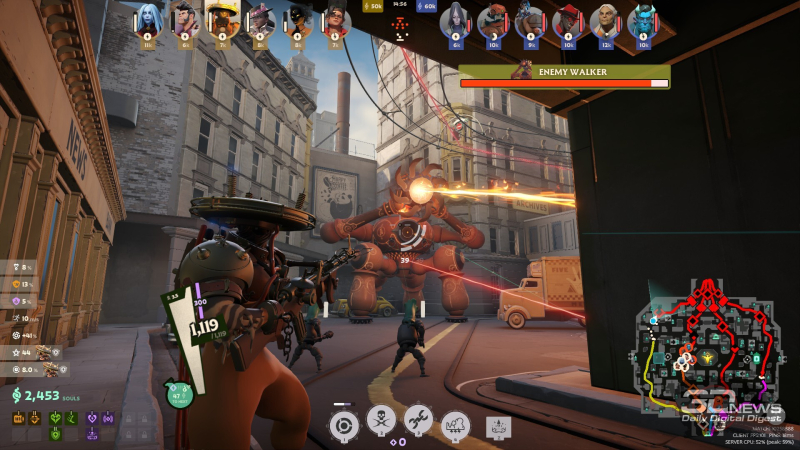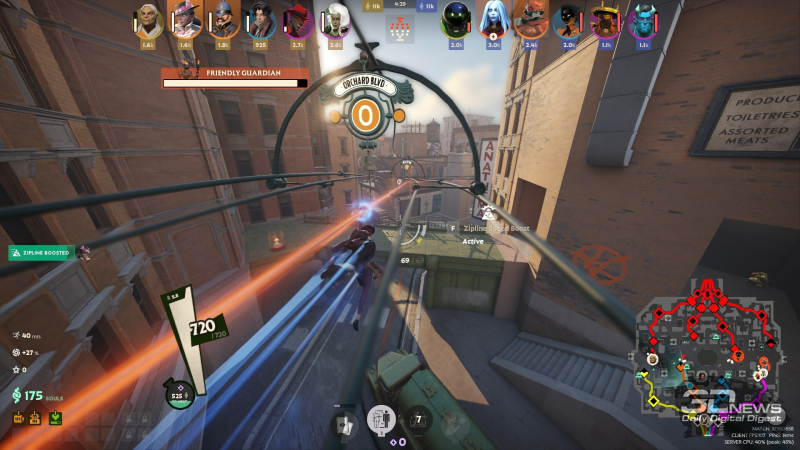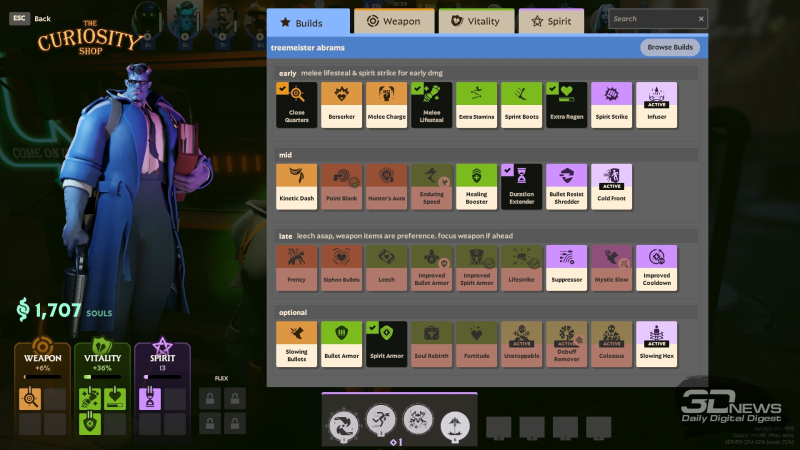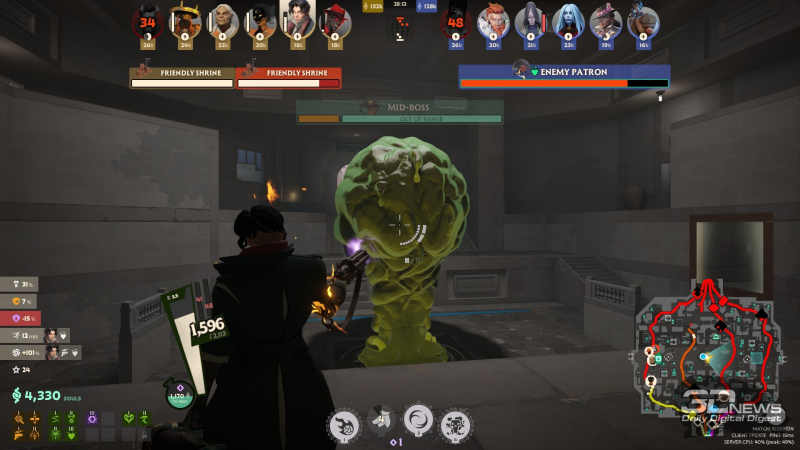Played on PC
A game from Valve is always a big event, because the studio every time tries to change the idea of the genre, creating not just a game, but a benchmark for the coming years. And, with rare exceptions, she always succeeded. So Deadlock clearly claims to be a genre standard – even in the conditions of a limited playtest (you must be invited to the game by those who already have access), the peak online of the experimental project is approaching two hundred thousand, streamers and content creators are delighted, and players are also enjoying an unusual MOBA I liked the third person view. This is despite the fact that the project is in an early stage of development (according to the description from the Deadlock Steam page), and many aspects need to be improved and polished. What kind of magic is this?

The fights are very visually intense
⇡#Successful experiment
The world of Deadlock visually resembles the works of the Arkane studio, and conceptually there are common points. Here we have an alternative New York of the thirties of the twentieth century, where fantastic technologies, otherworldly forces and occult practices coexist. It all comes together quite organically, although sometimes it seems that some graphic elements are somewhat out of tune with the overall mood of the project. However, at this stage of development this is quite natural.
In terms of gaming, the main reference point was projects of the MOBA genre. If you have played at least one, you will definitely feel at home: two teams, defense and advancement along the line, “farming creeps”, reinforced defense lines with towers and the final goal – a conditional “core” at the enemy base. And although all this sounds familiar, the nuances here fundamentally change the usual gaming experience.

The concept of defense towers is almost the same, except here they are guards and colossal walkers that incinerate uninvited guests
The main feature is, of course, the change from the classic isometric view to an over-the-shoulder camera, which already radically changes the approach to battles and tactics. The concept, of course, is not new: you can remember the long-dead Paragon, and, say, the still alive Smite or its sequel. But Deadlock doesn’t stop at simply translating the genre’s principles into a new visual perspective—it takes full advantage of the gameplay capabilities of third-person action. Here you will find dashing shootouts, fierce melee battles with the possibility of parrying, high-speed tackles, rebounds, jumps with rebounds, and this is not to mention the personal characteristics of the heroes, which we will discuss a little later. All this creates extraordinary dynamics on the battlefield – you can’t immediately recall multiplayer analogues.
The developers did not miss the opportunity to properly use verticality in the levels, which adds additional tension to fierce battles. A crushing and deadly attack can come from anywhere – the presented map is full of objects from which you can make daring attacks, and the labyrinth of streets opens up space for cunning maneuvers, sudden ambushes and deception techniques. To confidently use the features of the location, you will have to study all the nooks and crannies in detail – and this will require many games, because the map in Deadlock is quite large.

Fight with the wind!
The size is primarily due to the non-standard number of branches (as lines are called in Deadlock) – there are four of them, and not three, as is usually the case, so there are also more different transitions, tunnels and conditional “bushes” here. The large scale is balanced by increased mobility – each branch has a transit line along which you can quickly rush to the thick of the battle. It will not be possible to travel further – the transit ends at the point where our troops collided with soldiers or heroes of the other side.
The number of players in the team is also more than the usual five to six for the genre. Together with the increased number of lines, this creates a serious strategic dilemma – how to distribute among branches more competently and efficiently in order to get the maximum advantage. And although the game makes recommendations about the preferred branches for players, nothing prevents them from being distributed as they please, implementing more cunning and aggressive strategies. For example, select three heroes to attack on one branch instead of two, or identify two players to transfer between branches for rapid flanking attacks on unsuspecting enemy heroes. With coordinated work and the right combination of heroes, such a strategy can finish the game very quickly…

Competent procurement is no less important than combat skills and reaction
⇡#Twenty-one reasons to play
Deadlock offers twenty-one heroes. It’s impressive how diverse they are – first of all, of course, visually and conceptually: they all have their own memorable appearance, which also fits perfectly with the gameplay features of the characters. Even in small nuances and animations, the developers tried to put the very essence of each of the characters. For example, a funny detail: Infernus, who literally shoots fire from his fingers, shakes his hands when “reloading” to cool them down. And, say, the dude Zatochka not only rushes along the transit line, but does it as effectively as possible – clinging to it with his feet. Thanks to such little things, there are simply no faceless and passable heroes in Deadlock.
And in terms of game features, it’s even more interesting – the uniqueness and situationality of each hero is felt excellent. And although a clear division into classes has not yet been presented (and will there be one?), a conditional division into professional areas is still felt. Deadlock has a place for most of the popular roles from both MOBA games and session shooters like Overwatch. Those who like to shoot from afar will probably like Gray Claw and Reckoning, support will like McGinnis with her turrets and a building wall, power at mid-range will be provided by Mist, Seven and Shadow, and Abrams is frighteningly effective in close encounters (by the way, the character design is a witty reference to Hellboy ) or Sharpening. And of course, how can we do without the classic “pudge”: here his role is played by Bebop, but the principle is still the same – hook the enemy hero with a hook, pull him in, send him to the base for revival.

Ultimate abilities look impressive and effectively annihilate opponents
But even within a conventional category, the gameplay for each hero is unique in its own way – everyone has their own personal skills and a special absolute ability, which, as expected, can turn the tide of a battle, or even a match. It’s especially nice that literally all the heroes are quite easy to master at a basic level, but to hone your skills and demonstrate e-sports prowess, you will need more than a dozen hours.
The only noticeable disadvantage in this expanse is balance. Some of the characters are clearly too tough, like, say, Mist, Seven or Abrams – few will be able to cope with them in the later stages of the match. At the same time, some heroes like Gargoyle are noticeably inferior to others in effectiveness at all stages of the game.

Defeating the boss will give the entire team a reduced cooldown the next time they die – an incredibly useful effect in the late game
Basically, the late game is the most underdeveloped part of Deadlock at this point. And although the pace is rapid and, ideally, the game ends in twenty to thirty minutes, extremely exhausting episodes often occur when a team tries to take the enemy’s base by storm for an hour, dies, a counterattack occurs, is repulsed, and so on in a circle. And even taking the boss doesn’t always help in such dead ends. The game could probably use additional sources to gain a tangible advantage in battle in the later stages. However, Valve still has a lot of time to polish all the systems and mechanics of Deadlock.
***
Already, Deadlock is an incredibly addictive, amazingly fun and fresh project on the multiplayer gaming scene. I wouldn’t be surprised if other industry players have already started developing Deadlock “killers”, because this is a 100% future hit that will be played by millions. And although it is still far from its final form, its basic mechanics, high game pace, as well as colorful and memorable characters are already making it more interesting and exciting than most alternatives. We look forward to the full release!
Video: